Readily Achievable Barrier Removal
The ADA requires that small businesses remove architectural barriers in existing facilities when it is “readily achievable” to do so. Readily achievable means “easily accomplishable without much difficulty or expense.” This requirement is based on the size and resources of a business. So, businesses with more resources are expected to remove more barriers than businesses with fewer resources.
Readily achievable barrier removal may include providing an accessible route from a parking lot to the business’s entrance, installing an entrance ramp, widening a doorway, installing accessible door hardware, repositioning shelves, or moving tables, chairs, display racks, vending machines, or other furniture. When removing barriers, businesses are required to comply with the Standards to the extent possible. For example, where there is not enough space to install a ramp with a slope that complies with the Standards, a business may install a ramp with a slightly steeper slope. However, any deviation from the Standards must not pose a significant safety risk.
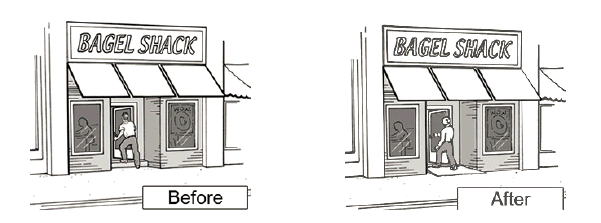
Removing barriers, such as a step to an entrance, is required when readily achievable.
Determining what is readily achievable will vary from business to business and sometimes from one year to the next. Changing economic conditions can be taken into consideration in determining what is readily achievable. Economic downturns may force many public accommodations to postpone removing some barriers. The barrier removal obligation is a continuing one and it is expected that a business will move forward with its barrier removal efforts when it rebounds from such downturns. For example, if a restaurant identified barriers under the 1991 Standards but did not remove them because it could not afford the cost, the restaurant has a continuing obligation to remove these barriers when it has the financial resources to do so.
Barrier Removal Before March 15, 2012
Businesses removing barriers before March 15, 2012, have the choice of using either the 1991 Standards or the 2010 Standards. You must use only one standard for removing barriers in an entire facility. For example, you cannot choose the 1991 Standards for accessible routes and the 2010 Standards for restrooms. (See, ADA 2010 Revised Requirements: Effective Date/Compliance Date at www.ada.gov/revised_effective_dates−2010.htm). Remember that if an element complies with the 1991 Standards, a business is not required to make any changes to that element until such time as the business decides to alter that element.
| Compliance Dates and Applicable Standards for Readily Achievable Barrier Removal, New Construction, and Alterations | |
| Compliance Date | Applicable Standard |
| Until March 15, 2012 | 1991 Standards or 2010 Standards |
| On or After March 15, 2012 | 2010 Standards |
Priorities for Barrier Removal
Understanding how customers arrive at and move through your business will go a long way in identifying existing barriers and setting priorities for their removal. Do people arrive on foot, by car, or by public transportation? Do you provide parking? How do customers enter and move about your business? The ADA regulations recommend the following priorities for barrier removal:
- Providing access to your business from public sidewalks, parking areas, and public transportation;
- Providing access to the goods and services your business offers;
- Providing access to public restrooms; and
- Removing barriers to other amenities offered to the public, such as drinking fountains.
Businesses should not wait until March 15, 2012 to identify existing barriers, but should begin now to evaluate their facilities and develop priorities for removing barriers. Businesses are also encouraged to consult with people with disabilities in their communities to identify barriers and establish priorities for removing them. A thorough evaluation and barrier removal plan, developed in consultation with the disability community, can save time and resources.
In some instances, especially in older buildings, it may not be readily achievable to remove some architectural barriers. For example, a restaurant with several steps leading to its entrance may determine that it cannot afford to install a ramp or a lift. In this situation, the restaurant must provide its services in another way if that is readily achievable, such as providing takeout service. Businesses should train staff on these alternatives and publicize them so customers with disabilities will know of their availability and how to access them.
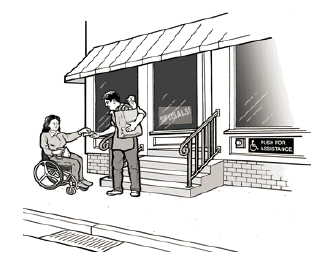
When barrier removal is not possible, alternatives such as curbside service should be provided.
Parking
If your business provides parking for the public, but there are no accessible spaces, you will lose potential customers. You must provide accessible parking spaces for cars and vans if it is readily achievable to do so. The chart below indicates the number of accessible spaces required by the 2010 Standards. One of every six spaces must be van accessible.
| Total Number of Parking Spaces Provided in Parking Facility | Minimum Number of Required Accessible Parking Spaces |
|---|---|
| 1 to 25 | 1 |
| 26 to 50 | 2 |
| 51 to 75 | 3 |
| 76 to 100 | 4 |
| 101 to 150 | 5 |
| 151 to 200 | 6 |
| 201 to 300 | 7 |
| 301 to 400 | 8 |
| 401 to 500 | 9 |
| 501 to 1000 | 2 percent of total |
| 1001 and over | 20, plus 1 for each 100, or fraction thereof, over 1000 |
Small businesses with very limited parking (four or fewer spaces) must have one accessible parking space. However, no signage is required.
An accessible parking space must have an access aisle, which allows a person using a wheelchair or other mobility device to get in and out of the car or van.
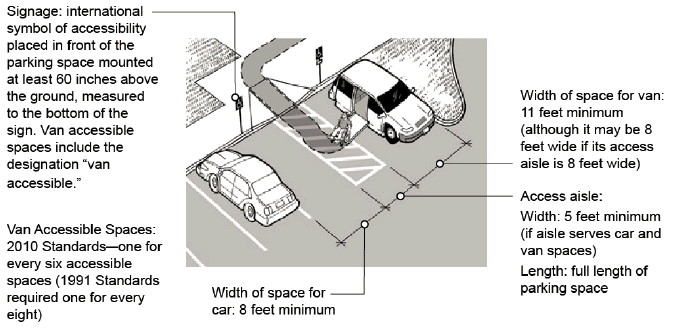
An overview of accessible parking requirements.
Accessible Entrances
One small step at an entrance can make it impossible for individuals using wheelchairs, walkers, canes, or other mobility devices to do business with you. Removing this barrier may be accomplished in a number of ways, such as installing a ramp or a lift or regrading the walkway to provide an accessible route. If the main entrance cannot be made accessible, an alternate accessible entrance can be used. If you have several entrances and only one is accessible, a sign should be posted at the inaccessible entrances directing individuals to the accessible entrance. This entrance must be open whenever other public entrances are open.
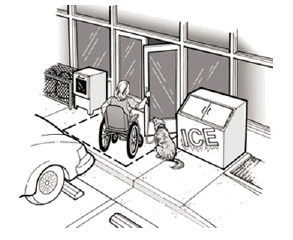
Ensuring that items do not block the accessible route allows independent access.
Accessible Route to Goods and Services
The path a person with a disability takes to enter and move through your business is called an “accessible route.” This route, which must be at least three feet wide, must remain accessible and not be blocked by items such as vending or ice machines, newspaper dispensers, furniture, filing cabinets, display racks, or potted plants. Similarly, accessible toilet stalls, dressing rooms, or counters at a cash register must not be cluttered with merchandise or supplies.
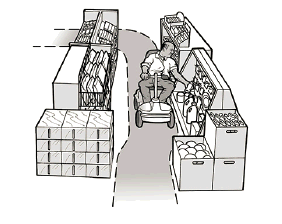
An accessible route allows customers using mobility devices to access items for sale.
Temporary access interruptions for maintenance, repair, or operational activities are permitted, but must be remedied as soon as possible and may not extend beyond a reasonable period of time. Businesses must be prepared to retrieve merchandise for customers during these interruptions. For example, if an aisle is temporarily blocked because shelves are being restocked, staff must be available to assist a customer with a disability who is unable to maneuver through that aisle. In addition, if an accessible feature such as an elevator breaks down, businesses must ensure that repairs are made promptly and that improper or inadequate maintenance does not cause repeated failures. Businesses must also ensure that no new barriers are created that impede access by customers with disabilities. For example, routinely storing a garbage bin or piling snow in accessible parking spaces makes them unusable and inaccessible to customers with mobility disabilities.
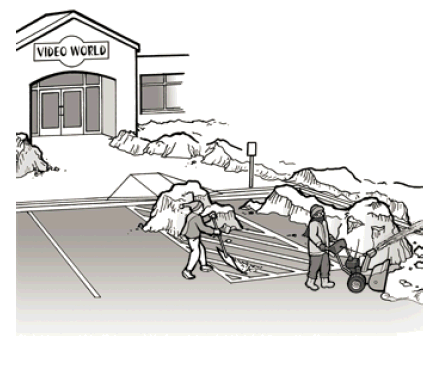
Snow or other debris in accessible parking spaces and access aisles must be removed as soon as possible.
Shelves, Sales and Service Counters, and Check-Out Aisles
The obligation to remove barriers also applies to merchandise shelves, sales and service counters, and check-out aisles. Shelves and counters must be on an accessible route with enough space to allow customers using mobility devices to access merchandise. However, shelves may be of any height since they are not subject to the ADA’s reach range requirements. Where barriers prevent access to these areas, they must be removed if readily achievable. However, businesses are not required to take any steps that would result in a significant loss of selling space. At least one check-out aisle must be usable by people with mobility disabilities, though more are required in larger stores. When it is not readily achievable to make a sales or service counter accessible, businesses should provide a folding shelf or a nearby accessible counter. If these changes are not readily achievable, businesses may provide a clip board or lap board until more permanent changes can be made.
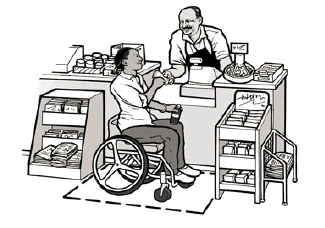
A lowered counter and clear floor space are critical components of an accessible service counter.
Food and Restaurant Services
People with disabilities need to access tables, food service lines, and condiment and beverage bars in restaurants, bars, or other establishments where food or drinks are sold. There must be an accessible route to all dining areas, including raised or sunken dining areas and outdoor dining areas, as well as to food service lines, service counters, and public restrooms. In a dining area, remember to arrange tables far enough apart so a person using a wheelchair can maneuver between the tables when patrons are sitting at them. Some accessible tables must be provided and must be dispersed throughout the dining area rather than clustered in a single location.
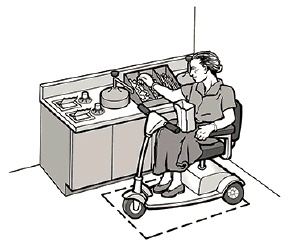
Restaurants must provide access to self-service items.
Where barriers prevent access to a raised, sunken, or outdoor dining area, they must be removed if readily achievable. If it is not readily achievable to construct an accessible route to these areas and distinct services (e.g., special menu items or different prices) are available in these areas, the restaurant must make these services available at the same price in the dining areas that are on an accessible route. In restaurants or bars with only standing tables, some accessible dining tables must be provided.

User Comments/Questions
Add Comment/Question